CyberPower Gamer Xtreme 8500: How Far Can SLI 450's Go?
by Dustin Sklavos on September 16, 2010 12:15 AM ESTGaming Performance on the CyberPower 8500
This is the part where things should get really interesting. The GeForce GTS 450's together cost about $280 total, while the Radeon HD 5870 in the AVADirect unit costs a staggering $410. Ryan's review of the GTS 450 saw the SLI setup nipping at the 5870's heels most of the time, but what happens when you overclock the crap out of the processor?
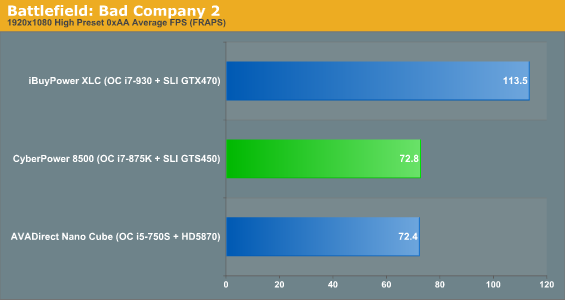
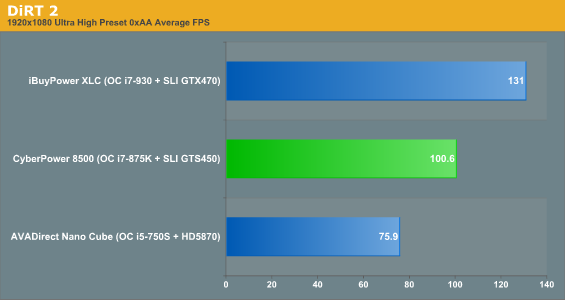
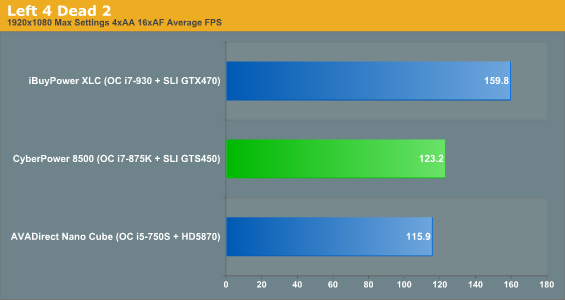
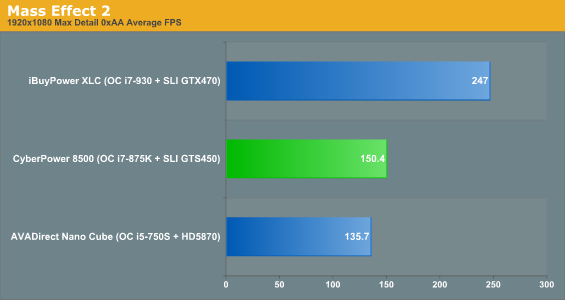

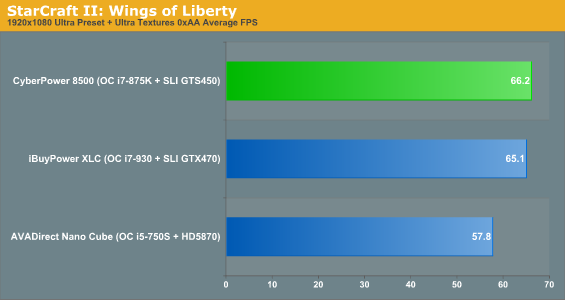
So what have we learned, kids? The overclock on the processor clearly isn't for naught, especially when you get into a game like StarCraft II that eats up as much CPU power as it can get. The 3.85GHz clock on the i7-875K gives the graphics subsystem room to breathe in situations where it would otherwise be CPU-limited, with the CyberPower unit besting the competition in StarCraft II and generally coming in reasonably ahead of the AVADirect unit with the slower CPU. Again, though, keep in mind: the Nano Cube is a Mini-ITX system that has much tighter thermal constraints than the two ATX systems it's showing up with here.
Let's see what happens when we put a tighter crunch on the graphics hardware.
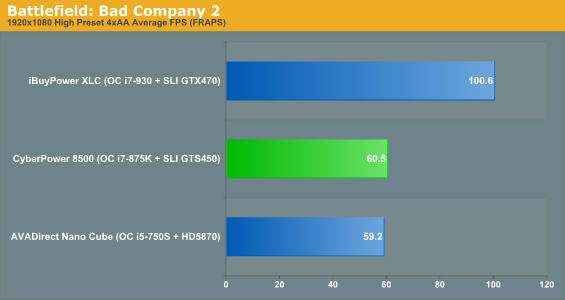

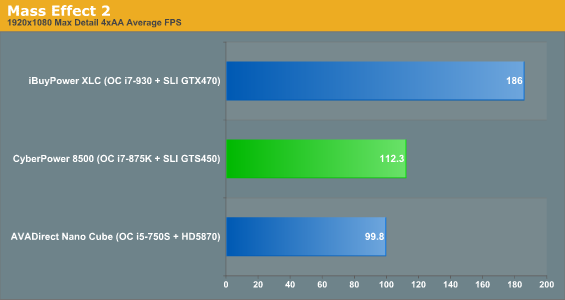
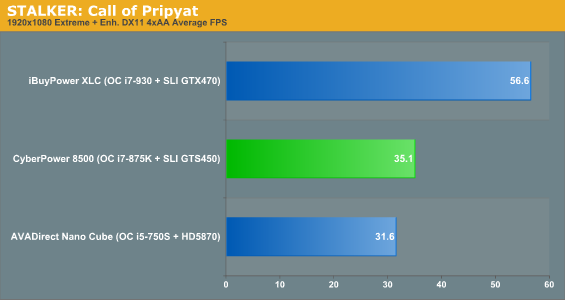

Here the fortunes change somewhat. The gap between the 8500 and the Nano Cube closes a little, the gap between the 8500 and the XLC widens, and now that anti-aliasing is taxing the graphics cards, the GTX 470's can flex their muscle in StarCraft II.










30 Comments
View All Comments
vol7ron - Thursday, September 16, 2010 - link
Not too bad for the price. The hard drive is kind of weak. I'd expect at least an 80GB SSDwolfman3k5 - Thursday, September 16, 2010 - link
It's to expensive for what it is. To me, a 40GB SSD doesn't make much sense. I'd rather have a 300GB VelociRaptor as an OS drive for that price. Anyway, great review. And again, the system isn't worth the price tag.Roland00 - Thursday, September 16, 2010 - link
40 GBs is enough for the OS and any non program you may want to install (with the exception of games.)Games don't benefit that much from random access times for most of their data is sequential, you just need a fast hard drive to access these (and many normal hard drives have similar sequential reads compared to a VR). The OS and other programs benefit muchly from an SSD since most of their data is random thus the access time matters much more than sequential reads.
My personal experience with ssds also backs this up.
Bitter - Thursday, September 16, 2010 - link
What about the power cosumption? Could be an important factor7Enigma - Thursday, September 16, 2010 - link
Seconded. Seems odd it was mentioned in the conclusion that it was idling in the 40's but then no power consumption, temp, or noise results. Seems like an entire section was left out.LtGoonRush - Thursday, September 16, 2010 - link
I see three main issues with this build, the liquid cooling system, the choice of SLI GTS 450s, and the low-end SSD. Using liquid cooling doesn't make much sense, as a high-end air cooler (like the Noctua NH-D14 or Thermalright Silver Arrow) provides better cooling performance, lower noise levels, and higher reliability, all at a lower pricepoint. The SLI GTS 450s are also a poor choice, as a single GTX 460 1GB offers very similar performance, but with substantially lower power usage and noise levels, and at a lower pricepoint. Finally, the use of a low-end, 40GB SSD really hamstrings the system, as there really isn't enough room after the installation of the OS for the games and other applications that you want to load quickly.By eliminating the unnecessary fan controller (~$60) and using a single GTX 460 1GB (~$60), CyberPower could have included a 120GB Sandforce-based SSD, providing ample capacity for a number of games, as well as substantially improving performance. Depending on the cost of the liquid cooling system they used, they may have even been able to upgrade to 8GB of RAM, though I'll grant that may have impacted their ability to run at 1600Mhz, and there aren't very many applications aside from desktop virtualization that need more than 4GB. This would have also given owners the option to upgrade to SLI GTX 460 1GB cards if desired at some point in the future, for truly formidable gaming performance.
Overall, this isn't a bad system, and I applaud their choice of an LGA-1156 processor, Asus motherboard, and Corsair power supply, but it seems like they made too many concessions to make the system LOOK extreme, rather than balancing it for the best performance possible.
Meaker10 - Thursday, September 16, 2010 - link
A small water cooling system is less likely to break in transit than some massive air cooler.The SSD is OS and a game only, but is perfectly acceptable for an OS drive (I have used one).
Hopefully you can configure and make your own balance.
Roland00 - Thursday, September 16, 2010 - link
Furthermore while it doesn't perform better, most people assume watercooling is better based on name. Some youthful people also think watercooling is more "elite."Thus sales wise you are more likely to sell the watercooled solution even if in reality good aircooling would have performed just as well.
acooke - Thursday, September 16, 2010 - link
The water cooling takes up less space. It's difficult to fit a high end air cooler in these boxes - there's not the vertical space.acooke - Thursday, September 16, 2010 - link
Duh. I'm an idiot. The review mentioned the Cube and so I assumed this was also small form factor, but I just read it again and it's not. Sorry.